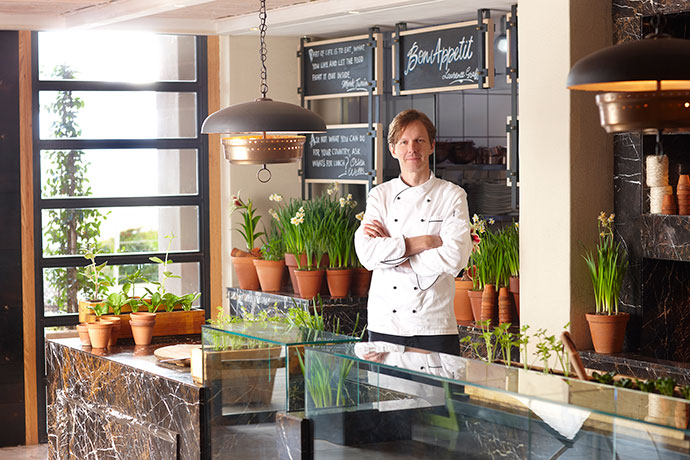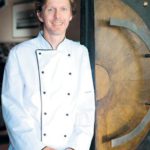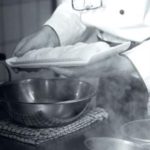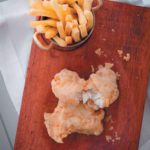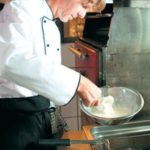Christiaan Campbell quietly hones his craft and creates fine-dining drama at Delaire Graff
Actors are warned to never work with children or animals, lest they be upstaged. Writers should never type at an open window, or they’ll get lost in the view. And chefs, I’d venture, should never cook in a setting so drop-dead gorgeous that your patrons’ food will surely be cold before they’ve dragged their eyes back to the plate.
From the deck of Delaire Graff Restaurant, perched on top of Helshoogte Pass outside Stellenbosch, it’s all but impossible not to gasp at the panoramic views of the Banhoek Valley and distant Du Toitskloof Mountains. Indoors, there’s just as much distraction courtesy of the soaring wooden rafters, stylish decor and world-class artworks from the private collection of the owner, diamond magnate Laurence Graff.
Certainly here, at the estate’s flagship restaurant, the focus is not purely on the plate, but it’s a challenge that executive chef Christiaan Campbell seems to relish. Don’t be surprised if you haven’t heard of him. An unassuming chef, he’s a man who has quietly gone about the business of honing his craft, from early days in the navy, through the production line kitchens of large hotels and, finally, to the boutique eateries better suited to his precise approach to cooking. And while his plates are complex, artful creations, there’s a happy lack of pretence about every dish that leaves his kitchen.
“My brief from the owner was to create a place where people can come and relax, so I’m trying to cook modern, trending food in an accessible and comforting manner,” says Christiaan, who joined the estate in 2009. “At the end of 2011 we took a hard look at the menu and reworked a number of elements,” explains Christiaan over coffee. “I wanted the food to be vibrant and not overworked; expressive, but showing lines of elegance. ‘Lines of discipline with elements of chaos’ is how I described the new approach to my team, because even though we’re playing around with the notion of comfort food, everything on the menu still has to match this impressive setting.
“I call it bistro-chic as there’s quite a bit of understatement on the plate, and I’m also using a lot of cuts that local diners perhaps aren’t familiar with: alongside sirloin and rump the dishes may use short rib or shin. And with pork I’ve been cooking a lot of neck sous vide.”
But there’s another more playful term Christiaan uses for his cooking, which I’m intrigued to find the origin of. “Sunshine cuisine?” chuckles Christiaan. “Well, thanks to all this sunshine our ingredients are just so vibrant and expressive, more so than in Europe, and I think that’s where South African chefs really have the upper hand.” Ingredients are a topic Christiaan returns to often during our chat, and within the boundaries of modern comfort food he’s a fan of introducing forgotten and unusual flavours to Cape palates: spätzle, cured octopus, bokkom broth and pine ring mushrooms all feature on his menu.
And like many Cape chefs, using local sustainable produce is non-negotiable. His menu is dictated by what is available, and much of the kitchen greens – peas, broad beans, fennel, herbs, pak choi and beetroot – are sourced from the estate’s sizeable vegetable garden.
“I’m very fortunate in my position here in that if I can’t find pasture-reared, ethically raised beef I simply won’t put it on the menu. We use Farmer Angus at Spier [featured on p13] for his pasture-reared beef and chicken, and I also get grass-fed beef brought down from a farm in KwaZulu-Natal. Our pork is from Happy Hogs near Ashton, and the lamb is sourced directly from a farm in the Northern Cape.
“For fish, I use green-listed angelfish, yellowtail or farmed cob 90 per cent of the time, and I’ve stopped buying prawns imported from Asia. It means I’m paying double for prawns from Mozambique, but it’s worth it.”
Sourcing free-range and ethically produced ingredients is almost always a more expensive option, but “chefs have a responsibility to make those good ethical decisions”, says Christiaan.
Much of that produce ends up in the charcoal-fired Josper oven, the centrepiece of Campbell’s state-of-the-art kitchen. Using radiated heat as well as grilling – at temperatures upwards of 400°C – it’s a fierce finish in perfect contrast to the slow and gentle sous vide that he uses for most cuts of meat.
It’s not the only balancing act in Christiaan’s kitchen. With plenty of overseas diners visiting for both the food and the views, he also has to walk a tightrope between creating a stylish and expressive dining experience on a par with the best in the world, while satisfying local appetites. Put diplomatically, South Africans don’t like to walk away hungry.
“It is a consideration, but I think we’ve struck a great balance between flavours and portions,” says Christiaan. “Some plates have more components than others, right down to our fish and chips, which is the owner’s favourite dish.”
Ah yes, the much-talked-about fish and chips. Seemingly out of place on the menu of a fine-dining restaurant, the R155 price tag makes it clear this is no ordinary plate.
“In a way ours is a menu of extremes,” admits Christiaan. “When I set out to create this dish I tried to do it the very best way we could: we cook the chips three times using top-quality potatoes, and we use export-quality line-caught hake. I tried all manner of experiments with the batter, but in the end I went back to basics: flour, water and yeast to make the most incredibly light and fluffy batter that gives a great finish.
Although it’s one of the most expensive hake and chips dishes in the country, people seem to really enjoy it!” Fish and chips is perhaps the last thing you’d expect to find on the menu at Delaire, but it’s simply more proof that any dish can be elevated to fine-dining status when given enough attention. After all, ice cream and porridge were transformed into must-eat dishes, thanks to one Mr Blumenthal.
While the sweeping views and eye-catching artwork provide the ‘wow’ factor, it’s the finer points of Delaire Graff that have made this one of the more memorable winelands eateries: the delicate arrangement of pea shoots atop cubes of smoky hake, the waiter who can tell the sauvignon blanc vintages apart, and the hours spent perfecting a free-standing crème brûlée. So forget the big picture or blue-sky thinking. Diners at Delaire would do well to pay scant attention to the mountains and leave the vineyard views alone. Here, the real drama is right in front of you, on the plate.
Delaire Graff Estate, Helshoogte Pass, Stellenbosch. Call 021-885-8160 or email [email protected]. www.delaire.co.za
Click here for Christiaan Campbell’s fish and chips
SOURCES
Photographs by Bruce Tuck
By Richard Holmes

